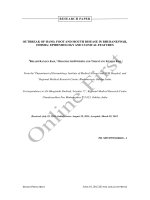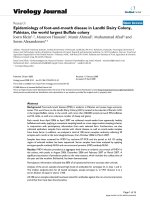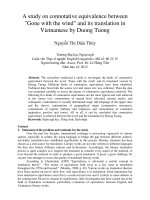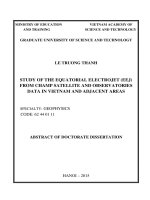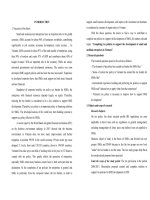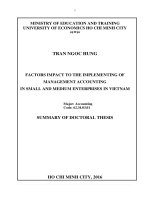To study clinical, subclinical features and causal viruses of Hand Foot and Mouth disease in Vietnam
Bạn đang xem bản rút gọn của tài liệu. Xem và tải ngay bản đầy đủ của tài liệu tại đây (521.39 KB, 12 trang )
1
2
1. INTRODUCTION
Hand Foot and Mouth disease (HFMD) is an infectious disease
transmitted from human to human, caused by enterovirus and easily to
become epidemic. HFMD is common in children under 5 year old,
transmitted mostly by intestinal route, directly mouth-mouth or fecesmouth. Since 1990s, many HFMD outbreaks have been reported in
South East Asia Pacific countries with fatal complications such as
meningo- encephalitis, myocarditis, pulmonary oedema, even leading to
deaths. In 2008, there was a HFMD outbreak in Taiwan with 347 severe
and complication cases and 14 deaths. In 2009, 1.1555.525 HFMD cases
were reported in China including 13 810 severe cases and 353 deaths.
Until now, there has not been specific treatment, therefore the
world tendency is to develop vaccin, early diagnosis and treatment to
reduce mortality. In Vietnam, HFMD epidemics often occur, may be
sporadic or spread. In HFMD outbreak in 2011,
113 121 cases
including 170 deaths were reported. There were some studies on
HFMD epidemiology and clinical characteristics in Vietnam.
However, these studies were conducted only in a few provinces and
in short term, so could not be representative for the whole country.
Moreover, their results were limited in diagnosis, not analysed in
depth predictive factors as well as clinical features caused by each
EV genotypes, that led to limitations in HFMD treatment and
prevention in Vietnam. Aiming to provide a overall description on
HFMD, on its common causal agents as well clinical features and
common complications in order to help to prevent the disease and
reduce its mortality, the study “To study clinical, subclinical
features and causal viruses of Hand Foot and Mouth disease in
Vietnam” was conducted with 3 objectives:
1. To evaluate clinical and subclinical features of HFMD in
Vietnam
2. To identify the main causal viruses of the disease
3. To analysis risk factors related to the severity and
complications of HFMD.
The data was from the National study on HFMD led by the National
hospital on Infectious and Tropical diseases, named: “To study
HFMD epidemiology, clinical features, diagnosis, treatment and
prevention in Vietnam” with the authorization from the study leader.
2. NEW FINDINGS OF THE THESIS
- This was the first thesis on HFMD conducted at the same time in
leading hospitals in whole coutry, so provided a overall
description on HFMD clinical, subclinical and causal viruses
characteristics in Vietnam.
- The study identified 2 main enteroviruses (EV) causing HFMD,
composing EV71 with predominant C4 subgenotype, and
Coxsackieviruses with predominant CA6 subgenotype. The result
also showed EV71 pathogenic role during this time period.
3. PRACTICAL VALUE OF THE THESIS
- The study identified HFMD predictive factors that help clinicians
in following patients and to give intervention in time to reduce the
mortality.
- The study identified EV71 subgenotype C4 as the main causal
virus. It was also the main cause of severity and complications,
therefore could be selected as the candidate for HFMD vaccin
development.
4. THE LAY OUT OF THE THESIS
The dissertation consist of 131 pages (excluding appendice),
including Introduction (2 pages), Overview (40 pages), Subjects and
Study methods (20 pages), Results (36 pages), Discussion (30 pages),
Conclusion (2 pages), Recommendations (1 page), 42 tables, 21
charts, 10 photos and 120 references.
CHAPTER 1: OVERVIEW
1.1. Situation of Hand Foot and Mouth disease (HFMD)
The disease was first described in Toronto-Canada in 1957. It
was called Hand Foot and Mouth disease during an epidemic in
3
4
Birmingham- England in 1959. With Coxsackie A16, EV71 were the
main cause of the disease. Since the end of 1990s, HFMD outbreaks
occured in Pacific Asian countries such as China, Singapore, Taiwan,
Malaysia with a number of CNS, cardiac and pulmonary
complications.
In Vietnam, HFMD occurs sporadically during the year in almost
provinces especially in the South. An HFMD outbreak was reported
in 2011 with 113121 cases including 170 deaths.
Not all enteroviruses can cause HFMD. Common causes are
EV71, Coxsackievirus, Echoviruses and some other enteroviruses.
EV71 includes 4 genogroup A, B, C and D. A and D genogroup
have only one subgenotype for each. That of subgroup A is BrCr.
Genogroup B is divided into 6 subgenotypes: B1–5 and B0.
Genogroup C is divided into 5 subgenotypes: C1-5.
Coxsackieviruses are divided into 2 subgroups A and B.
Subgroup A includes 24 subgenotypes caussing diseases for human,
among that CA16 is one critical cause of HFMD. Other subgenotypes
can cause HFMD including CA5, CA6, CA7, CA9 and CA10 .
Coxsackievirus B subgroup includes 6 subgenotypes among that B1,
B2, B3, B5 can also cause HFMD.
Transmission route:
- HFMD occurs in all ages, but commonly in children. Human
is the only source. The disease is transmitted directly from human
to human predominantly by feca-oral route, and may be transmitted
through respiratory-oral route by direct contact with nasal droplets,
saliva and skin vesicles or indirect contact through the patients toys,
house items and floor..infected of their discharge. HFMD occurs
sporadically in whole year but more frequently in the summer and
autumn. The disease is common in poor hygien countries.
1.3. Clinical, subclinical feature, diagnosis and treatment of Hand
Foot and Mouth disease.
1.2. Etiology
Enterovirus cause HFMD
Enterovirus is 1 among 7 genus belonging to Picornaviridae
family, Picornavirales order, a large group of a single positive-strand
genomic RNA. The enteroviruses are icosahedral nonenveloped
viruses that are approximately 30 nm in diameter. They have a capsid
composed of 60 subunits, each formed from 4 proteins (VP1 to VP4).
A linear, single-strand RNA genome of about 7.4 kb is enclosed by
the capsid; the translation product is a single polyprotein that is
cleaved after translation by viral-coded proteases into the structural
proteins (VP1 to VP4), RNA polymerase, proteases, and other
nonstructural proteins. There is a VPg protein 5’untranslated region
composing ribosom- binding sequence type I (IRES). P1 region
encodes structure proteins. P2 and P3 region encode nonstructure
proteins relating to virus replication. 5’ UTR is followed by 3’ UTR
and poly A tail. 3’ UTR has important role in minus-strand RNA
synthesis.
Without lipid envelope, enterovirus are stable at enviromental
condition like stomach pH. They can exist in the room temperature
for some days. Enteroviruses resist to lipid dissolution solven (as
ether and chloroform), ethanol but are inactive at temperature of over
560C, clo, formaldehyde and ultra-violet ray..
1.3.1. Clinical symtoms
Specific symtoms include: not high fever, rash in specific sites
(around mouth, palms, soles, buttock and knees), mouth ulcers,
bowel disorders (vomit, diarhea).
Most patient develop benign and recover spontanely within 7-10
days if there aren’t complications.
1.3.2. Complications
- CNS complication: encephalitis, brain stem encephalitis,
meningoencephalitis and menigitis. Common symptoms are frequent
myoclonus jerk, tremors, ataxia, nystagmus, seizure and coma.
5
6
- Cardiac complication: myocarditis, heart faillure. Common
symptoms are tarchycardia, hypertension followed by hypotension
and shock.
- Respiratory complication: pneumonia, OAP. Common
symptoms are short breaths, dyspnea, leading to respiratory faillure.
- Clinical: specific rash and vesicular on mouth, palm, sole , knee
and buttock, with or without fever.
- Confimatiory test: RT-PCR or isolated test for EV is positive.
1.3.3. Subclinical tests
1.3.3.1. Biochemical and hematological exams
WBC nornal or lightly increased. CRP normal or lightly
increased. VS often increased. CSF disorder when CNS complication
occurs (pleocytes with hypermonocytosis, lightly increased protein).
1.3.3.2. Imaging findings.
Celebral CT and MRI help to define lesions location in the brain.
Cardioechography, ECG and Troponin I should be done to detect
myocarditis and cardiac shock. Chest X ray performed when
respiratory complication suspected. Common lesions on X ray are
interstitial pneumonia or bilateral infiltrate in pulmonary oedema.
1.3.3.3. Etiology diagnosis test
- Technics PCR (Polymerase chain reaction), RT-PCR (Reverse
Transcription Polymerase Chain Reaction) are commonly applied as
high sensitivity and specificity.
- Sequencing technic: permit to define EV genotypes and
subgenotypes.
- Virus isolate by culture: require long time and high technic.
Define EV71serotypes after culture by neutralization test using
specific antibody for each serotypes.
- Technic of immunoglobulin IgM detection of EV71 is being
developed but may have false positive and not high sensitivity.
- Indirect immunofluorescence assay (IFA) tests using anti-EV71
monoclonal antibodies can provide rapid result, but with high
expense.
1.3.4. Diagnosis confirmation
- Epidemiology: based on age, season, epidemic areas, number of
infected children at the same time.
1.3.5. Treatmen and prevention
There is not yet specific treatment for HFMD. Symptom
treatment, follow-up to detect and control complications.
Prevention: there is not yet HFMD vaccine. Prevention mostly by
hygien keeping and contaminated source avoiding.
CHAPTER 2: STUDY SUBJECTS AND METHODS
2.1. Study period and sites
2.1.1. Time period for patients inclusion: from August 2011 to
December 2012.
2.1.2. Study sites: patients enrolled from 5 leading hospitals
representative for the whole country:
− In the North:
+ National hospital for Tropical diseases
+ National Pediatric Hospital
−
In the South:
+ Pediatric Hospital 1
+ Pediatric Hospital 2
+ HCMC Hospital for Tropical disease.
2.2. Study subjects
2.2.1. Inclusion criteria
All patients having enough 3 following criteria:
a/ Be confirmly diagnosed of HFMD according to WHO and MOH
guidlines (2011), including:
−
Clinical: patients living in epidemic areas and presenting one
or more HFMD clinical symptoms: fever, rash on specific
sites, mouth ulcers.
−
Tests: patients having throat fluid RT-PCR positive with
enterovirus.
7
b/ Patients admitted to hospital and be followed until they are stable.
c/ Patients parents or family members approve of patient
participating to the study.
2.2.2. Exclusion criteria
− Patients evidently infected of other infectious disease at the
point of enrollment.
− Patients infected or exposured to HIV.
− Patients not followed up at hospital until stable.
8
c. HFMD severe and complication cases definition
- Severe cases: defined if patients at clinical grade of 2B or more
according to MOH guideline (2011)
- Complication cases: defined if patients having following criteria:
+ Clinical grade of 2B or more .
+ At least one among neurological, cardiac and pulmonary
complications.
2.3.3. Study procedure
2.3. Study methods
2.3.1. Study design: Cross descriptive study with analysis.
2.3.2. Sample size and sample selection
a. Sample size
- Sample size estimated base on calculation formula of cross study:
n = Z2 (1-α/2) p. (1-p)/(d)2
Among that:
n: number of patients
p:
prevalence of EV positive test. According some report in
Vietnam, prevalence of EV positive test with specimen from
throat fluid were over 50%, therefore we took p = 0,5.
Z: 1,96 with α = 0,05.
d:
absolute exactitude.
Using WHO sample size estimation tool version 2.00 , with d
= 0.05 and 1- α = 95, we have the minimum sample size = 385.
b. Sample selection
Full sample size. All clinical suspected cases were screened for
oral swab test. Specimens were stored at each hospital then were
transferred to National Hospital for Tropical diseases for RT-PCR
test to define causal viruses.
Only clinical cases having oral swab RT-PCR positive test were
selected for the study.
Diagram 2.1. Study procedure
9
10
2.4. Ethical cosideration
The study was one part of the National level study led by the
National Hospital for Tropical disease, that received the approval from
the hospital IRB committee.
2.5. Data analysis
The collected data was analysed by statistic sofware SPSS version
18.0. Statistic threshold p=0,05 for all analysis tests.
2.6. Study limitation
The study was limited in hospitalized patients. The number of
inpatiens of the North much lower than that of the South, therefore
we could not compare clinical features of the two patient groups.
The male patients took 63,5%, higher than the female (36,5%).
Male/female ratio was 1,7:1.
CHAPTER 3: STUDY RESULTS
1170 HFMD inpatients from 50/64 provinces of the whole
country eligible for the study. The results as following:
3.1. HFMD clinical and subclinical features
3.1.1. Study population information
Chart 3.1. Age distribution
97,7% patients under 60 age months (5 year old), including 88,4%
children from under 36 months (3 year old).
Chart 3.4. HFMD distribution at admission point during 2012
During the year 2012, HFMD patients admitted sporadically in all
months, more frequenly in the spring (February to April) and begin
of autumn (July to September).
3.1.2. HFMD clinical features
Chart 3.6. Time from clinical beginning to admission point
Most HFMD patients admitted in the first 4 days of the disease (93%).
Table 3.2. The HFMD common symptoms
Symptoms
Rash
Oral ulcer
Fever
Myoclonus
Vomit
Diarhea
n = 1170
1070
865
726
601
159
62
%
91,5
73,9
62,1
51,4
13,6
5,3
HFMD common clinical symptoms were: rash (91,5%), oral ulcer
(73,9%), fever (62,1%) and myoclonus ( 51,4%).
Chart 3.2. Sex distribution
11
12
Intestinal symptoms such as vomit and diarhea took low
prevalences (13,6% and 5,3%).
3.1.2.4. Clinical grade
Of the total 1170 patients, 288 ones having complications
(24,6%). Among that, neurological one was the most common
(67,7%). Cardiac and pulmonary complications were less
common, taking 24,3% and 22,2%, respectively.
Chart 3.7. Clinical grade
Chart 3.9. Complication prevalence
Of patients having neurological, cardiac or pulmonary complications:
− 70,8% patients having 1 complication.
− 22,6% patients having 2 of the 3 complications combined.
− 6,6% patients having all the 3 complications
3.1.4. HFMD subclinical features
3.1.4.1. Hematological test
Table 3.7. Chages in WBC, Platlet counts and VS
Indicators
Counts
n
%
>16 000 cells/mm3
151
WBC
20,9
10-16000cells/mm3
358
(n=724)
49,4
<10000 cells/mm3
215
29,7
Median ± SD: 12613±4492 cells/mm3
Variance: 2190- 29 950 cells/mm3
≤ 400 000 tb/mm3
592
Platlet
71,7
>400 000 tb/mm3
133
(n=725)
18,3
Median ±SD: 323 646 ± 94 980 cells/mm3
Variance: 41 900 – 702 000 cells/mm3
117
VS
Increased
94,4
(n=124)
Median ±SD: 38,3± 21,4 mm/h
Variance: 2 - 264 mm/h.
20,9% had WBC increased over 16 000 cells/mm3. 18,3% had
platlet count over > 40000 cells/mm3. 94,4% had increased VS.
Patients admitted at all 4 clinical grade, mostly at grade 2A
(73,8%). 15,3% patients admitted at severe situation (at grade 2B,
grade 3 or grade 4).
3.1.2.5. Clinical grade progression during admission
Table 3.4. Clinical grade progression during admission
Grade at
admission
Grade 1(n=128)
Grade 2A(n=863)
Grade 2B (n=132)
Grade 3(n=42)
Grade to wich illness progressed (%)
Grade2A Grade2B Grade 3 Grade 4
41,9
1,2
5,8
0
7,1
4,6
0,2
25,8
1,5
7,1
Total
48,9
11,9
27,3
7,1
Prevalence of patients progressed to higher grade during
admission from grade 1, 2A, 2B and grade 3 were 31,4%, 11,9%,
27,3% and 7,1%, respectively.
3.1.3. HFMD complications
Chart 3.8. HFMD complications (n=288)
13
14
3.1.4.2. Biochemical test
Table 3.8. Biochemical test results
Increased
Indicators
Median
Variance
n
%
21,6
5,6 ± 2,2
2,0 - 27,9
Glucose (mmol/l) (n=468) 101
58
32,4
41,3 ± 28,3 17,5 - 340
AST (U/L) (n=179)
13
7,3
24,0 ± 30,1
6,1 - 270
ALT (U/L) (n=179)
17
7,2
59,5±16
1- 1410
CK (U/L) (n=234)
2 cases positive, taking 7,7%
Troponin I (n=26)
32,4% had increased AST , 21,6% had increased glycemia
3.2. HFMD viral causes
EV71 and Coxsackievirus were 2 main causes of HFMD.
Besides, Echovirus and other EVs also presented in the study.
3.2.1. RT-PCR test detecting EV71 and other EVs
Chart 3.13. EV71 subgenotypes prevalence
Of all EV71 cases,
C genogroup identified including
subgenotypes C2, C4, C5, with C4 subgenotype (including C4A and
C4B) was at highest prevalence (86,3%). EV71 genogroup B
included B0, B2, B4, B5 subgenotypes, with B5 subgenotypes was
at highest (9,5%), the rest took only from 0,2% to 1,9%.
Chart 3.12. EV71 and other EVs prevalence by RT-PCR
1170 oral swab specimens were tested for EV by RT-PCR. Result
was: EV71(638/1170) taking 54,5%; other EVs (532/1170) taking
45,5%.
3.2.2. Result of sequecing test
3.2.2.1. Identifying HFMD causing EV subgroups
Table 3.12. Prevalence of EV subgroups
EV groups
EV 71
Coxsackievirus
Echovirus
Other EV groups
Total
n
484
179
15
32
710
%
68,2
25,2
2,1
4,5
100
Chart 3.14. Coxsackievirus subgenotypes prevalence
HFMD causing Coxsackievirusé included Coxsackievirus
subgroup A (2,6,7,9,10,13,16) and Coxsackievirus subgroup B
(1,2,3,4,5). Of that, Coxsackie A6 was the most common (67,6%),
followed by Coxsackie A16 (11,7%), then Coxsackie A10 with 6,1%.
15
16
3.2.2.2. EV main subgenotypes causing HFMD
n=710
Chart 3.15. EV main subgenotypes causing HFMD
Of the total 710 specimens sucessfully done sequencing test for
EV subgenotypes, EV71-C4 subgenotypes taking 58,9% and
Coxsackie A6 taking 17% were define as 2 main EV subgenotypes
causing HFMD in Vietnam.
3.3. HFMD predictive factors
3.3.1. Clinical symptoms associated with the disease severity.
The multivariate analysis showed the following factors associated
with the disease severity: myoclonus , not oral ulcer, high fever over
38,5ºC with p <0,05 and OR were 4,4(95%CI 3,2-6,1); 2,2(95%CI
1,6-3,0) and 2,7(95%CI 2,1-3,8), respectively .
3.3.2. Subclinical changes associated with the disease severity
The analysis on hematological indicators showed that proportion
of HFMD patients having platelet counts over 400 000 cells/mm3
and WBC over 16000 cells/mm3 in severe group were significantly
higher than that in not severe group with p < 0,05 and OR were
2,2(95%CI 1,5-3,3) and 1,5(95%CI 1,1-2,2), respectively.
The analysis on biochemical indicators showed that proportions of
HFMD patients having increased AST and hyperglycemia in severe
group were significantly higher than that in not severe group with p<
0,05 and OR were 2,4(95%CI 1,2-4,7) and 2,9(95%CI 1,8-4,6),
respectively.
3.3.3. Causal virus associated with the disease severity and
complications
Analysis on EV71 and other EVs patient groups showed that the
proportion of severity and complication were significantly higher in
the former group with p <0,05 and OR=2,2 (95%CI 1,6-2,9)
Proportions of neurological, pulmonary and cardiac complication
in EV71 patients groups were significantly higher than that in other
EVs group with p<0,05 and OR were 1,9 (95%CI 1,4-2,6) ;
2,5(95%CI 1,4-4,4) and 1,9(95%CI 1,1-3,2), significantly .
Analysis on genogroup B and genogroup C of EV71 showed that
severity proportion in EV71 genogroup C was significantly higher than
that in genogroup B with p <0,05 and OR=4,5(95%CI 1,9-8,7).
Proportion of patients having neurological complication in
genogroup C was 25,6%, significantly higher than 2,0 % in
genogroup B (p <0,05). 7,2% patients in genogroup C had pulmonary
complication while there weren’t any patients having this
complication in genogroup B.
Analysis on EV71-C4 and CA6 patient groups showed that the
severity proportion in the EV71-C4 patient group was higher than that
in CA6 group. The difference was significant with p <0,05 and
OR=6,2(95%CI 3,2-9,9). The proportions of neurological,
pulmonary and cardiac complications among EV71-C4 infected
patients was significantly higher than that of CA6 infected patients
with p< 0,05 and OR were 4,4(95%CI 2,2-9,0) ; 6,8( 95%CI 2,29,0) and 5,4(95%CI (1,3-10,0), respectively.
CHAPTER 4: DISCUSSION
4.1. HFMD clinical, subclinical features and prognosis
4.1.1. Study population information
4.1.1.1. Age distribution
Result from the chart 3.1 showed that most admitted patients
(97,7%) were from under 5 year old (60 months), including 88,4%
among them from under 3 year old (36 months). Our result was
17
18
equivalent to that of Phan Văn Tú’ study in the South of Vietnam in
2005 as well as previous studies in other countries in the area.
the first 3 days of the disease, even more than 50% patients presented
fever, oral ulcer and rash on the first day of the disease. These were
clinical symptoms that help the disease early diagnosis.
4.1.1.2. Sex distribution
In this study, HFMD male patients proportion was 63,5%,
significantly higher than that of female patients (36,5%) (chart 3.2).
Male/female ratio was 1,7:1. Study of Trương Hữu Khanh in the year
2011 also had similar result with 62% male patients.
4.1.1.4. Disease distribution at admission point during the year 2012
It was shown that HFMD cases admitted sporadically in all
months of the year 2012, at 2 peaks being in the spring (February to
April) then in the begin of the autumn (July to September), then
decreased to the end of the year. Jin-feng Wang and colleagues
found a significant association between the climate and HFMD
occurrence. Our result was similar to that of the study conducted by
Phan Văn Tú showing the number of HFMD admitted cases was
highest in the February and March of the year.
4.1.2. Clinical features
4.1.2.2.Time from clinical beginning to admission point
Most patients (93%) admitted in the first 4 days of the disease.
The result showed that HFMD progressed rapidly, therefore media
education was necessary to recommend parents to follow up ill
children carefully and transfer them to hospital timely.
4.1.2.3. Clinical symptoms and progression
HFMD clinical common symptoms were skin rash taking the
highest proportion (91,5%), followed by oral ulcer (73,9%). Fever
was the third with 62,1%. The result was suitable to MOH definition
on HFMD wich may or may not have fever. Besides, HFMD patients
had intestinal symptoms such as vomit taking 13,6% and diarhea
taking 5,3%.
Studying on clinical symptom progression, we found that
HFMD symptoms occurred early. Most symptoms occurred during
- In the study, myoclonus was at the proportion of 51,4%. This
prevalence was lower than that of previous studies conducted in the
Pediatric Hospital 1(74,5%). The difference may be due to different
inclusion criteria and study sites. The result showed that myoclonus
was one earliest neurological sign in HFMD and was an important
one that helps physicians to diagnose the disease and follow up
patients to early detect severe situation.
4.1.2.4. Clinical grade progression during admission
The clinical grade proportions at admission point composed
Grade 1 with 10,3%, grade 2A with 73,8%, grade 2B with 11,3%,
grade 3 with 3,6% and grade 4 with only 0,4%. Truong Huu Khanh
conducting a study on HFMD at Pediatric Hospital 1 in the year 2011
also reported similar results with proportions respectively of
17,73,9,1 and 0,4%. Proportions of clinical grades progressed from
grade 1, grade 2A, 2B and grade 3 during hospitalizations were
respectively 31,4%, 11,9%, 27,3% and 7,1%, also similar to the sudy
of Truong Huu Khanh. This showed that HFMD patients should be
followed up carefully during admission to be decteted early severe
progression and be timely managed.
4.1.3. The disease complications
288 among total 1170 patients ( 24,6%) being at grade 2b and
more and having severe signs were divided into neurological,
cardiac and pulmonary complication groups. Among that groups,
neurological one took the highest prevalence with 67,7%. Our result
was equivalent to that of other authors in the country and area,
showing that neurological complication was predominant in HFMD.
Pulmonary and cardiac complications were less common with the
respectively proportions of 22,2% and 24,3%. Some authors
suggested that in HFMD nerological lesions were at brain stem,
19
20
cardiac pulmonary center, therefore cardiac and pulmonary
complications often followed neurological complications and were
consequence of brain stem damages. However, the mechanism has
been clear until now. We also found that patients could have
combinations of neurological, cardiac and pulmonary complications.
Of the total 1170 patients identified as EV infected by RT-PCR
test, 638 ones positive with EV71 (taking 54,5%), 532 others were
identified as other EVs infected (chiếm 45,5%) (chart 3.12). The
result was equivalent to other studies in the area, showing that EV71
was the common cause in HFMD epidemics. When comparing to
other datas in Vietnam, we found that previous reports on EV71 were
often sporadically concentrated in some provinces. Our study may be
one first and complete report on EV and EV71 infection in HFMD
patients in the whole country.
4.1.4. Subclinical features
4.1.4.1.Hematological test
The blood formula results showed that over 50% patiens had
WBC counts increased to more than 10 000 cells/mm3. Analysing
WBC counts according to clinical grages, it was found that the
proportions of patients having WBC counts increased to more than
16000 cells/mm3 in groups of clinical grade 2B and more were
higher than that in groups of clinical grade 1 and 2A. Đoan Thi Ngoc
Diep and Li also saw that in HFMD patient severe group WBC
counts were often highly increased. Even Jiahua in a HFMD study in
the year 2012 showed that WBC counts of over 17 000 cells/mm3
was one severe predictor. Like with WBC, our study also showed
that the patients having platlet counts over 400 000 cells/mm3 seen in
group of clinical grade 2B and more with higher proportion as compared
to that in group of grade 1 và 2A. These are indicators to be analysed for
severe predictive factors.
4.1.4.2. Biochemical test (table 3.8)
Our study showed that proportion of patients having
hyperglycemia was 21,6% and increase AST was 32,4% while only
7,3% patients having increased ALT. Patients having increased CK
took 7,2%. AST may be increased in liver injury and also in
myocardiac injury. Therefore it is necessary to have more study on
the mechanism of increased AST in HFMD.
4.2.2. Sequencing test detecting EV subgenotypes causing HFMD
It was showed that main enteroviruses causing HFMD in
Vietnam composed EV71 at highest prevalance, followed by
Coxsackievirus, Echovirus and other EVs.
Sequencing test to identify EV71 subgenotypes found that C4
subgenotype was predominant (86,3%), followed by B5
subgenotypes (9,5%). Lê Phan Kim Thoa in a HFMD study
conducted in the South of Vietnam in 2011 also reported that EV71C4 subgenotype took 94% of EV71 infected cases.
Sequencing test identified also Coxsackievirus A and B
subgroups as HFMD viral causes in Vietnam. Among that, CA6
subgenotype was predominant (67,6%), followed by CA16 (11,7%).
This is new point of the study because CA16 used to be reported as
one most common cause of HFMD in previous studies in Vietnam.
This result however was equivalent to HFMD conducted by Tsuguto
in Japan in the year 2011, reporting CA6 subgenotype as HFMD
predominant cause. That reflected the diversity of HFMD viral
causes during different time periods.
4.3. HFMD predictive factors
4.2. HFMD viral causes
4.3.1. Clinically
4.2.1. RT-PCR test detecting EV71 and other EVs
The multivariate analysis showed that clinical symptoms
associated to the disease severity were high fever at > 38,5º C
21
22
(OR=2,72), myoclonus (OR= 4,4) and no oral ulcer (OR=2,2), with p
<0,05. The result was similar to previous studies conducted in the
country and abroad as in China and Malaysia and provided more
evidence for MOH guideline on HFMD, in that ill children with high
fever at ≥ 39º C were graded at 2A and should be admitted for taking
care. Studies by Phan Van Tu (2005) and by Trương Thị Triet Ngu
(2007) reported that children having oral ulcers had more ability of
Coxsackievirus infection than of EV71 infection so their clinical
situations therefore were less severe. Besides, the study showed that
not all patients having myoclonus at beginning developed to severe
situation and neurological complication. MOH guideline classified
patients at clinical grade 2B and more when patients presented
myoclonus during examination with frequency of 2 times or more
in 30 minuts. So physicians during clinical examination should not
only detect myoclonus but also its frequency to identify
neurological complication and severe situation in order to it timely
control.
issue need more studies. However, the above results would help
physicians to prognose for timely management and reducing the
mortality.
4.3.2. Subclinical
Analysis on association between hematological indicators and the
disease severity showed that WBC counts > 16000 cells/mm3 and
platlet counts > 400 000 cells/mm3 were severity predictive factors.
This result was similar to previous studies in the area. May be the
WBC and platlet counts increasing related to inflammatory reaction
in HFMD. The more severe situation, the more inflammation was and
the more WBC and platlet counts increased.
Analysis on the association between biochemical indicators and
the disease severity showed that increased AST and hyperglycemia
were severity predictive factors. Glycemia increased in severe
patients may due to inflammatory mechanism in that catecholamin
increased as the result of autonomy nervous system disorders. AST
not only increased in liver injury but also in myocardiac injury. Was
AST increasing an indicator of myocardiac injury in HFMD? This
4.3.3. Viral causes
It was found that EV71 patient group had severe case as well as
neurological, cardiac and pulmonary complication proportion higher
than that of other EVs patient group. Wang and colleagues studying
in Shenzhen (China) reported that all severe cases in 2009 were
infected by EV71. The result was similar to HFMD epidemic
finding in 2011 in Vietnam. It was shown that patients in EV71
genogroup C had higher incidence of severe case and neurological,
cardiac and pulmonary complications as compared to EV71
genogroup B patients. This was a new point of our study because
there haven’t been any reports in Vietnam on comparison between
EV71 genogroup B and genogroup C clinical features. Proportions
of severe cases and complications in EV71-C4 infected group were
higher than that in CA6 infected group. The result showed that in the
HFMD epidemic in Vietnam in 2012, EV71 subgenotype C4 was the
main cause of severe cases. This was similar to previous reports in
the country and area on HFMD epidemiology and on EV71 including
C4 pathogenicity. The above result provided more important
epidemiological and clinical information, helping high risk causal
viruses selection for the vaccin development studies.
CONCLUSION
1. HFMD clinical, subclinical features in Vietnam
- The disease occured in the whole year, at peak in the spring
(Feb-Apr) and at the begin of autumn (Jul- Sep), mostly in children
from under 5 year old (97,7%) including 88,4% of under 3 year old.
Male patients were predominant (63,5%). Male/female ratio was
1,7:1.
23
24
- Most patients admitted in the firrs 4 days of the disease (93%).
Common clinical signs: erythema (91,5%); oral ulcer (73,9%); fever
(62,1%); myoclonus (51,4%); vomit (13,6%), diarhea (5,3%).
- Prevalence of patients progressed to higher grade during
admission from grade 1, 2A, 2B and grade 3 were 31,4%, 11,9%,
27,3% and 7,1%, respectively
- 24,6% patients had complications including neurological,
cardiac and pulmonary ones. Among them:
+ Neurological complication most common (67,7%),
followed by cardiac (24,3%) and pulmonary ones (22%).
+ 70,8% presented one complication, 22,8% with 2
combined complications and 6,6% had all 3 ones.
- Blood test:
+ Hematological: increased WBC (20,9% over 16 000
cells/mm3), increased VS (94,4%),
+ Biochemical: increased AST (32,4%), hyperglycemia
(21,6%).
3. HFMD predictive factors
Severity predictive factors included:
- Clinical: high fever over 38,5ºC (OR=2,7), myoclonus
(OR=4,4) and oral not ulcer (OR=2,2), with p <0,05.
- Subclinical:
+ Hematological: Platlete count over 400 000 cells/mm3
(OR=2,2), WBC count over 16 000 cells/mm3 (OR=1,5)
+ Biochemical : increased AST (OR=2,4) and hyperglycemie
(OR=2,9), with p <0,05.
- Causal virus: The proportions of severe and complicated
patients were higher in :
+ EV71 infected group compared to other EVs infected
+ EV71 genogroup C compared to genogroup B
+ EV71- C4 subgenotypes compared to CA6 subgenotype
The difference was significant with p < 0,05 and OR >1.
2. HFMD viral causes
- Result from RT-PCR test to detect EVs: EV71 took 54,5%,
other Evs took 45,5%.
- Result from sequencing test to detect EV subgenotypes:
+ Main EV groups causing HFMD: EV71(68,2%), Coxsackievirus
(25,2%), Echovirus (2,1%) and other EVs (4,5%).
•
•
EV71 included genogroup C (C4, C2 và C5) and genogroup
B (B0, B2, B4, B5). Among that EV71-C4 subgenotype was
predominant (86,3%), followed by B5 subgenotype (9,5%).
Coxsackieviruses included A and B subgroups. Among that,
Coxsackie A6 was predominant (67,6%), followed by
Coxsackie A16 (11,7%) and Coxsackie A10 (6,1%).
+ 2 main EV subgenotypes causing HFMD: EV71-C4 (58,9%)
and Coxsackie A6 (17%).
RECOMMENDATIONS
1. To add the severity predictive factors to the HFMD diagnosis
and management.
2. To select EV71-C4 subgenotype as candidate for HFMD
vaccin development.
